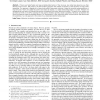26 search results - page 5 / 6 » Programmable shaders for deformation rendering |
VIS
2007
IEEE
14 years 6 months ago
2007
IEEE
Proteins are highly flexible and large amplitude deformations of their structure, also called slow dynamics, are often decisive to their function. We present a two-level rendering ...
SI3D
2005
ACM
13 years 11 months ago
2005
ACM
We present a simple yet effective snapping technique for constraining the motion of the cursor of an input device to the surface of 3D models whose geometry is arbitrarily deforme...
ASIASIM
2004
Springer
13 years 10 months ago
2004
Springer
This paper presents an efficient self-collision detection algorithm for deformable body simulation using programmable graphics processing units (GPUs). The proposed approach store...
VISUALIZATION
2005
IEEE
13 years 11 months ago
2005
IEEE
For the rendering of vector and tensor fields, several texturebased volumetric rendering methods were presented in recent years. While they have indisputable merits, the classica...
CGF
2006
13 years 5 months ago
2006
Based on the potential of current programmable GPUs, recently several approaches were developed that use the GPU to calculate deformations of surfaces like the folding of cloth or...

